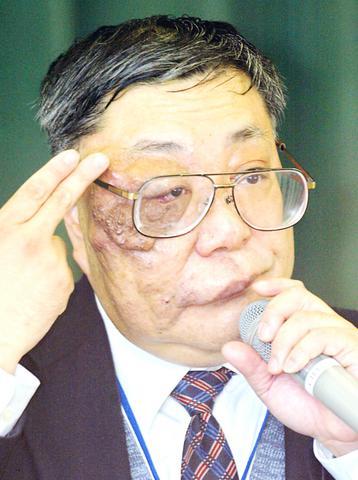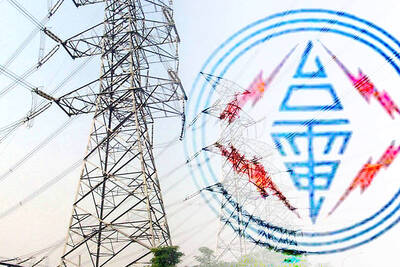Tei and Masaharu Fujii named their much-awaited baby son Teruaki -- meaning "shining bright" in Japanese -- in 1957, not knowing he would be called a "monster" within a few years.
A pink, round mark began to show on Teruaki's right cheek when he was two, an omen for harsh discrimination he was to endure later in life.
The mark was an angioma, a benign tumor consisting of dilated blood vessels.

PHOTO: AFP
By his early 20s, the red-blue spongy collection of blood vessels had spread to his nose and mid-forehead with the swelling around his upper lip dangling like a miniature elephant trunk.
But his affliction also gave him a medical vocation.
Fujii, 46, is now professor of nursing science at state-run Kumamoto University in southern Japan.
With the release of his autobiography, entitled Face of Destiny, last October, Fujii became a torch bearer for 1 million people in Japan with deformed faces.
"Many of those people tend to cloister themselves at home as others look daggers at them," Fujii said in a recent interview.
"I urge those people to go out and tell others `I suffer, my heart aches,'" from the way they are treated, said Fujii, who has frequently been spat at in the street.
"I have been saying the same thing for two decades ... but there are finally moves to break down the invisible wall" between the handicapped and others, he said.
Despite the changing times, former leprosy patients at the Kikuchi Keifuen sanatorium recently found themselves discriminated against.
A hotel in a hot spring spa town refused to honor reservations for 22 people from Keifuen last November, seven years after Japan ended its 89-year forcible seclusion of lepers.
A court ordered the hotel to pay a fine of 20,000 yen (US$185), the same penalty as for speeding.
The sanatorium dates back to 1910 and houses some 560 people suffering after-effects or complications from the disease.
"Some could not even go back to their hometown after they died," Fujii said, adding the sanatorium keeps the ashes of 1,200 such people.
Inmates still adopt pseudonyms for fear their families might be tracked down and discriminated against, he said.
It was only in June 2001 that Japan's parliament apologized to lepers who had suffered forcible sterilization, forced abortions and other human rights abuses.
Fujii knows only too well what it feels like to suffer discrimination because of one's looks.
He used to keep his face down on his way to kindergarten so other people would not notice his mark.
On his first day at primary school, a boy called Fujii "monster," sparking off mass chanting of the cruel nickname by other children.
When he was 14, Fujii felt acute pain in the tumor.
"I was woken up one summer night as I felt burning as if a boiling kettle was pressed against my face. The mark was swelling with tiny rashes spreading over it," he wrote in his book.
"It was a horrifying scene like small worms wriggling under the skin ... Something was getting unruly in my face," he said, recalling his battle against fears his face might "explode" someday.
Fujii entered the economics department of private Chuo University in Tokyo in 1978.
With the right half of his face deformed, he was never invited to parties with girls. Students would move to another seat if he sat next to them and discrimination continued when he started looking for a job.
Although he was a top student armed with a written recommendation from the principal, he was rejected by 50 companies.
"The financial business is a service industry, so we can't hire a monster like you," a company recruitment official said.
The turning point in Fujii's life came when he went to a Red Cross lecture and a doctor urged him to pursue a medical career, arguing he could understand the pain and sorrow of those with serious diseases.
He underwent a 10-hour operation in April 1982 to remove the bulk of the tumor at the hospital where the doctor worked, and later started working at the computer department there.
Even the surgery left a bitter memory -- one of the doctors involved in the operation kept the removed tumor as a specimen without his consent.
That infuriated Fujii, who vowed to find out how insensitive doctors can be to patients.
He entered Chiba College of Health Science to study nursing science at the age of 28 and became a professor at Kumamoto University in 2000.
Fujii also visits schools to tell children how unfair discrimination is, letting them touch the soft, warm tumor in which his pulse can be felt.
Although he has come to think the tumor is "not so bad," Fujii admits to suffering emotional conflict with a yearning for a face free of
abnormalities.

A vaccine to fight dementia? It turns out there may already be one — shots that prevent painful shingles also appear to protect aging brains. A new study found shingles vaccination cut older adults’ risk of developing dementia over the next seven years by 20 percent. The research, published Wednesday in the journal Nature, is part of growing understanding about how many factors influence brain health as we age — and what we can do about it. “It’s a very robust finding,” said lead researcher Pascal Geldsetzer of Stanford University. And “women seem to benefit more,” important as they’re at higher risk of

March 31 to April 6 On May 13, 1950, National Taiwan University Hospital otolaryngologist Su You-peng (蘇友鵬) was summoned to the director’s office. He thought someone had complained about him practicing the violin at night, but when he entered the room, he knew something was terribly wrong. He saw several burly men who appeared to be government secret agents, and three other resident doctors: internist Hsu Chiang (許強), dermatologist Hu Pao-chen (胡寶珍) and ophthalmologist Hu Hsin-lin (胡鑫麟). They were handcuffed, herded onto two jeeps and taken to the Secrecy Bureau (保密局) for questioning. Su was still in his doctor’s robes at

Last week the Democratic Progressive Party (DPP) said that the budget cuts voted for by the China-aligned parties in the legislature, are intended to force the DPP to hike electricity rates. The public would then blame it for the rate hike. It’s fairly clear that the first part of that is correct. Slashing the budget of state-run Taiwan Power Co (Taipower, 台電) is a move intended to cause discontent with the DPP when electricity rates go up. Taipower’s debt, NT$422.9 billion (US$12.78 billion), is one of the numerous permanent crises created by the nation’s construction-industrial state and the developmentalist mentality it

Experts say that the devastating earthquake in Myanmar on Friday was likely the strongest to hit the country in decades, with disaster modeling suggesting thousands could be dead. Automatic assessments from the US Geological Survey (USGS) said the shallow 7.7-magnitude quake northwest of the central Myanmar city of Sagaing triggered a red alert for shaking-related fatalities and economic losses. “High casualties and extensive damage are probable and the disaster is likely widespread,” it said, locating the epicentre near the central Myanmar city of Mandalay, home to more than a million people. Myanmar’s ruling junta said on Saturday morning that the number killed had